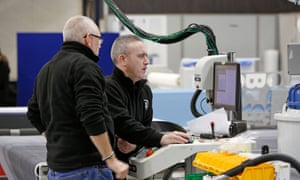It had all been going so well. In this smoothest of seductions, John Clark and Alistair Miller hadn’t had to do a thing. There they were, itching to sell their business and get on with retirement. Then one day in the middle of 2015, this American firm – big-time, way out of their league – swung by the factory outside Glasgow and asked: what price do you have in mind? This was followed by an invitation back to the multinational’s European headquarters in the home counties.
So off popped Miller. The two sides were inching towards the dotted line when he casually inquired what the Americans would do with their new Scottish premises. This one question sent the needle screeching across the record.
As soon as the managing director across the desk started talking about “exploring possibilities” and “transferable technologies”, Miller knew what she meant. Their Scottish operation would run for another six months, a year tops. Then it would be shut – and the order book and the technology shifted down south. And when the factory disappeared, so too would the jobs and the livelihoods of 60-odd workers and their families. Selling up would hand the owners a huge cheque, and leave their staff on a tiny giro.
“You’d be sitting back with your piles of cash,” says Clark, “but at some point you’re going to bump into those guys. Some of them have been there longer than me. I know their families.”
“Those guys” helped to build this place. Since its launch in 1986, Novograf has gone from printing signs for vans to working with some of the biggest chains in Britain. It has become expert in the branding that envelops you while shopping, eating or holidaying, but which you never take in. Walk around a Co-op supermarket, and the signs guiding you to the wine and beer or fruit and veg aisles will be Novograf’s. Pop into a Pizza Hut and the wood-look flooring will have been made and laid by Novograf employees. Stay at an Ibis Styles hotel and the big fat number on your room door probably comes from their East Kilbride factory. Then there’s Greggs, Iceland, Tesco, Waitrose …
Miller and Clark hadn’t poured six decades of their combined lives into this venture only to leave a plump carcass for others to feed on. But the two sixtysomethings had run smack into one of the central problems of British capitalism: how to ensure a company’s owners look after it. Pretty much any spiv with a chequebook can buy a business in the UK and ruin it as they want. Westminster will ask few questions, expect even less accountability, and never learn any lessons. That fanatical British adherence to open markets and property rights leaves the staff, the suppliers and the public counting for little.
The publisher of Horny Housewives, Richard Desmond, bought the Express stable in 2000 without New Labour ministers raising an eyebrow. A once-great paper was wrecked and hundreds of journalists lost their jobs, but Desmond pocketed nearly £350m before he sold it to Trinity Mirror this year.
In 2005, Manchester United football club was snapped up by the Glazer family, who paid for it by borrowing hundreds of millions that they loaded on to the club’s balance sheet – before shifting its headquarters to the tax haven of the Cayman Islands, a 10,000-mile round trip from the club’s Old Trafford stadium.
Philip Green may strip BHS bare; Cadbury can be ravaged by Kraft; Australian investment bank Macquarie can run Thames Water into the ground then, as a reward, get the public’s Green Investment Bank. Each time owners damage a business, employees and often customers get shafted, and local economies suffer – while a handful right at the top cash in.
But Miller and Clark can tell you how much depends on the simple fact of ownership. It helps shape the business model, the ethos and culture of a company. However, even as they tried to secure a careful owner for their business, all the plausible options were a no-go.
Sell to a rival? Their staff and values would be discarded like used wrapping paper. Cash out to private equity? A green light for a corporate ransacking. Neither man’s children wanted to trudge in their dad’s footsteps, and senior management were not in a position to buy them out.

‘I could be sitting back on piles of cash. But at some point you’re going to bump into those guys. I know their families.’ John Clark, chairman and former owner of Navograf. Photograph: Murdo Macleod for the Guardian
Just then, a postcard flopped on to the doormat. “Thinking of exiting your business?” it asked. When the man from Scottish Enterprise, an agency of the Holyrood government, told them about worker ownership, he got blank faces. The biggest employee-owned firm in the UK, John Lewis, was a Novograf customer, yet all Clark knew about its structure was that once a year the company would be on the news for paying “partners” a tax-free bonus. Which was lovely, Clark and Miller thought, but what did that have to do with them?
Employee ownership is as simple as selling a company to its staff. Over 300 British firms have done it, from Arup architects to Waitrose. But it is as radical as giving the people who create a business’s wealth the right to share in it. That wealth is no longer handed over to remote shareholders in the form of share buybacks and dividends.
When Clark and Miller “got off our butts” and visited a few of the 95 Scottish firms now owned by their employees, “we learned that their productivity was higher, that they were more resilient in bad times, that they were more inclusive of all their staff”.
Giving workers control over their companies doesn’t just make the firms more successful, it also makes the workers a lot better off. Last year, the California-based National Center for Employee Ownership analysed US jobs figures and found that younger workers who are worker-owners enjoy 33% higher wages and 92% higher median household wealththan those who aren’t owners.
The British government knows much of this, because it commissioned a report that told it so. The very first line of Graeme Nuttall’s 2012 review reads: “Employee ownership is a great idea.” After lobbying by Liberal Democrat ministers, two years later chancellor George Osborne scrapped capital gains tax for employers who transferred a majority share of their business to workers. This was back when Osborne and David Cameron would hymn “the John Lewis model”.
Just like “the march of the makers” and the “big society”, the fad has left little trace. Of the 2,617 full-time equivalent civil servants at the Department for Business, not one is dedicated to promoting worker ownership, as advised by the Nuttall review. The same report also recommends “the appointment of a minister responsible for promoting employee ownership across government”. Yet this department confirmed to me that not even its most junior minister holds any such brief.
That silence partly explains why employee ownership remains so exotic. When Clark and Miller announced their idea for selling the company to their staff, they hired a local hotel, put on fancy nibbles and gave a great presentation. “The very first question we got was, ‘Have we still got a job?’” remembers Clark. “Nobody had a clue what it meant,” recalls factory technician David Anderson. “People assumed that everyone was going to have to get a mortgage to buy the company.”
Four hundred miles north of Whitehall, the far smaller Scottish Enterprise employs eight full-time staffers to promote and advise on worker ownership and other “inclusive models” of organising companies. The SNP government is full-square behind it, and the Herald, the Record and the Scotsman newspapers trumpet this Inverness holiday resort or that Hebridean jewellers being taken over by its employees.
Just two decades ago, newly devolved Holyrood paid through the nose for inward investment and prayed that the multinationals would repay their lavish subsidies with lasting jobs. They rarely did. Hewlett Packard, Chunghwa Picture Tubes and many others pulled the corporate equivalent of a one-night stand.
‘Everyone received a decent tax-free bonus last year, and also took part in the first-ever staff survey, which led to sick-pay and leave entitlement becoming more generous.’ Photograph: Murdo Macleod for the Guardian
Holyrood can still relapse – such as when it gifted Amazon £2.5m of taxpayers’ money and got back a distribution warehouse in Dunfermline. But Scottish Enterprise’s Sarah Deas talks of fostering a Mittelstand – a German-style dense network of medium-sized businesses that think long term and honour their social obligations.
Which is a reminder that British business is not some political monolith – that it can break left as well as right. White-haired Clark is appalled at “the FTSE guys”, the chief executives paid 100 times the average wage of their workers. “What are they doing to deserve that?”
Clark is not, he says, “some paternalistic capitalist” or a “crusader”. He’s “hardnosed”, and with Miller got a fair price for Novograf. But they’ve also taken big risks to ensure their workers could afford it. It proved impossible to raise cash upfront for the purchase price. “Not one of the major banks was interested. Not even our own.” So Clark and Miller turned themselves into a bank – handing over the company shares while allowing employees to pay them back over a few years, with interest. And with conditions: as long as the pair retain an interest in the firm it cannot relocate more than 200 miles away, “because that would defeat the entire purpose of the deal”.
At the end of 2016, all the shares in the company were transferred from the two original owners into a trust held on behalf of all staff. Just over a year later, the all-new, same-old Novograf still feels eggshelly, as if everyone is trying to gauge what’s changed. Its new managing director, Jennifer Riddell-Dillet, has to tell employees: “Remember you’re an owner.” She both manages and works for her staff, one of whom sat on the panel that interviewed her for the job.
Novografers like to tell you that this isn’t “some socialist paradise”, that there are still bosses and workers; but the priorities have changed. Formerly a senior manager for two PLCs, Riddell-Dillet says: “Public companies are only about external shareholders. There, employees are the asset of the business – but they’re a sweatable asset. Here, you think, ‘If I just drive them into the ground it will be less fulfilling, less rewarding and it will be more ruthless.’”
Everyone received a decent tax-free bonus last year, and also took part in the first-ever staff survey, which led to sick pay and leave entitlement becoming more generous. Anderson, a Novograf lifer, says: “The people on the factory floor definitely feel more in control than before. Anybody can now say, ‘I don’t see why things have to be done that way’ – and someone’s got to answer.”
That power requires some growing into. Production manager Michael Carr has become a director of Novograf, and has struggled to get his head around the accounts. And with no previous experience, Anderson and business development manager Margaret Nelson now make up half the trustee board. The other two trustees will be Miller and Clark, until they’re finally paid off. “It’s obvious that they know what they’re talking about and we don’t,” says Nelson. “Challenging your old boss is an intimidating thing.”
But employees will challenge on their expert subject: their daily work. Just last week, an employee showed Carr a cheaper and quicker way of assembling signs. They would never have spoken up before, he says, yet that one simple thing could save “a few thousand pounds in man-hours and material”.
In its first full year of employee ownership, Novograf’s sales shot up 20% and the company took on an extra 22 people. That success followed on from a strong performance in 2016, but Riddell-Dillet reckons their direct stake in the outcome did drive employees to put in “the blood, sweat and tears”.
Not all the savings are strictly necessary. Not so long ago, now-chairman John Clark, while washing his hands in the gents, reached over to the soap dispenser. He remembers a thin jet of lotion flying out – “Whoosh ... it hit me amidships” – all over his stomach. He charged over to the man responsible for ordering in supplies and told him the new soap was far too thin. While Clark stood dripping, the man nodded. “Aye, that was me,” he said. “I’ve watered down the soap by half to save money.”
Holyrood can still relapse – such as when it gifted Amazon £2.5m of taxpayers’ money and got back a distribution warehouse in Dunfermline. But Scottish Enterprise’s Sarah Deas talks of fostering a Mittelstand – a German-style dense network of medium-sized businesses that think long term and honour their social obligations.
Which is a reminder that British business is not some political monolith – that it can break left as well as right. White-haired Clark is appalled at “the FTSE guys”, the chief executives paid 100 times the average wage of their workers. “What are they doing to deserve that?”
Clark is not, he says, “some paternalistic capitalist” or a “crusader”. He’s “hardnosed”, and with Miller got a fair price for Novograf. But they’ve also taken big risks to ensure their workers could afford it. It proved impossible to raise cash upfront for the purchase price. “Not one of the major banks was interested. Not even our own.” So Clark and Miller turned themselves into a bank – handing over the company shares while allowing employees to pay them back over a few years, with interest. And with conditions: as long as the pair retain an interest in the firm it cannot relocate more than 200 miles away, “because that would defeat the entire purpose of the deal”.
At the end of 2016, all the shares in the company were transferred from the two original owners into a trust held on behalf of all staff. Just over a year later, the all-new, same-old Novograf still feels eggshelly, as if everyone is trying to gauge what’s changed. Its new managing director, Jennifer Riddell-Dillet, has to tell employees: “Remember you’re an owner.” She both manages and works for her staff, one of whom sat on the panel that interviewed her for the job.
Novografers like to tell you that this isn’t “some socialist paradise”, that there are still bosses and workers; but the priorities have changed. Formerly a senior manager for two PLCs, Riddell-Dillet says: “Public companies are only about external shareholders. There, employees are the asset of the business – but they’re a sweatable asset. Here, you think, ‘If I just drive them into the ground it will be less fulfilling, less rewarding and it will be more ruthless.’”
Everyone received a decent tax-free bonus last year, and also took part in the first-ever staff survey, which led to sick pay and leave entitlement becoming more generous. Anderson, a Novograf lifer, says: “The people on the factory floor definitely feel more in control than before. Anybody can now say, ‘I don’t see why things have to be done that way’ – and someone’s got to answer.”
That power requires some growing into. Production manager Michael Carr has become a director of Novograf, and has struggled to get his head around the accounts. And with no previous experience, Anderson and business development manager Margaret Nelson now make up half the trustee board. The other two trustees will be Miller and Clark, until they’re finally paid off. “It’s obvious that they know what they’re talking about and we don’t,” says Nelson. “Challenging your old boss is an intimidating thing.”
But employees will challenge on their expert subject: their daily work. Just last week, an employee showed Carr a cheaper and quicker way of assembling signs. They would never have spoken up before, he says, yet that one simple thing could save “a few thousand pounds in man-hours and material”.
In its first full year of employee ownership, Novograf’s sales shot up 20% and the company took on an extra 22 people. That success followed on from a strong performance in 2016, but Riddell-Dillet reckons their direct stake in the outcome did drive employees to put in “the blood, sweat and tears”.
Not all the savings are strictly necessary. Not so long ago, now-chairman John Clark, while washing his hands in the gents, reached over to the soap dispenser. He remembers a thin jet of lotion flying out – “Whoosh ... it hit me amidships” – all over his stomach. He charged over to the man responsible for ordering in supplies and told him the new soap was far too thin. While Clark stood dripping, the man nodded. “Aye, that was me,” he said. “I’ve watered down the soap by half to save money.”








